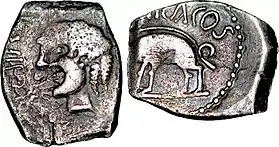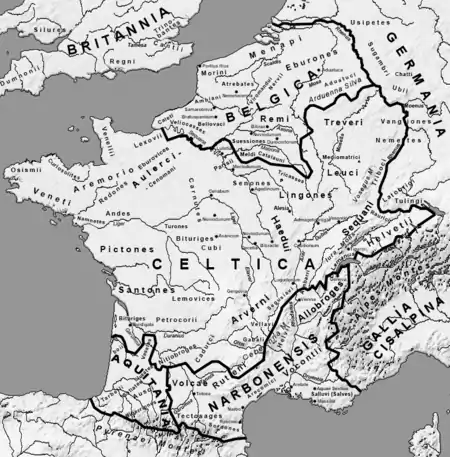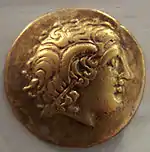Ruteni
The Ruteni were a Gallic tribe dwelling in the southern part of the Massif Central during the Iron Age and the Roman period.

Name
They are mentioned as Rutenos by Caesar (mid-1st c. BC),[1] R̔outēnoì (Ῥουτηνοὶ; var. Ῥουταινοὶ) by Strabo (early 1st c. AD),[2] Ruteni (var. roteni, rutheni) by Pliny (1st c. AD),[3] Ruteni by Lucan,[4] and as R̔outanoì (Ῥουτανοὶ) by Ptolemy (2nd c. AD).[5][6]
The Celticity of the name remains uncertain.[7][6] It has been tentatively translated as 'the blond ones' by extrapolating from a description of the Roman poet Lucan ("The fair-haired Ruteni were freed from the garrison that long had held them").[8]
The city of Rodez, attested ca. 400 AD as civitas Rutenorum ('civitas of the Ruteni'; in urbe Rutena in the 9th c., Rodes ca. 1183), and the region of Rouergue, attested as in pago Rodonico in 767 (Rodengue, Rodergue in 1150, Roengue ca. 1182), are named after the Gallic tribe.[9]
Geography

The Ruteni dwelled in the southern part of the Massif Central, in the later province of Rouergue, north of the river Tarn. Their territory was situated south of the Arverni, east of the Cadurci, west of the Gabali and north of the Volcae.[10][11] Because they were vassals of the Arveni, part of their territory was taken by the Romans after the defeat of the Arvenian king Bituitus in 121 BC.[11]
During the reign of Augustus, Segodunum (modern Rodez) became the main town of their civitas.[11]
History
In 121 BC, they fought along with the Arveni against Rome.[10]
During the Gallic Wars (58–50 BC), they sent 12,000 men to the Battle of Alesia in 52 BC.[11]
References
- Caesar. Commentarii de Bello Gallico, 1:45:2.
- Strabo. Geōgraphiká, 4:2:2.
- Pliny. Naturalis Historia, 4:109.
- Lucanus. Pharsalia, 1:400.
- Ptolemy. Geōgraphikḕ Hyphḗgēsis, 2:7:12.
- Falileyev 2010, s.v. Ruteni and Civitas Rutenorum.
- Evans 1967, pp. 466–467.
- An historical geography of France by Xavier de Planhol, Paul Claval p.10
- Nègre 1990, p. 156.
- Kruta 2000, p. 799.
- Demarolle 2006.
- Ancient Rome at Work: An Economic History of Rome from the Origins to the Empire by Paul Louis p.180
Bibliography
- Demarolle, Jeanne-Marie (2006). "Ruteni". Brill's New Pauly. doi:10.1163/1574-9347_bnp_e1025990.
- Evans, D. Ellis (1967). Gaulish Personal Names: A Study of Some Continental Celtic Formations. Clarendon Press. OCLC 468437906.
- Falileyev, Alexander (2010). Dictionary of Continental Celtic Place-names: A Celtic Companion to the Barrington Atlas of the Greek and Roman World. CMCS. ISBN 978-0955718236.
- Kruta, Venceslas (2000). Les Celtes, histoire et dictionnaire : des origines à la romanisation et au christianisme. Robert Laffont. ISBN 2-221-05690-6.
- Nègre, Ernest (1990). Toponymie générale de la France. Librairie Droz. ISBN 978-2-600-02883-7.
